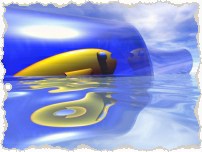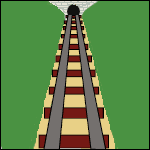Bluebottle's Beebies Blog
Created | Updated May 16, 2010

Bluebottle spends too much time watching children's television.
Having a child or two under the age of three, I, an adult, watch children's television - in particular, the CBeebies channel. My son, who has just turned two, calls television "Beebies", and "Beebies" was one of his first words. Other television related first words include "Poop Poop" for Thomas The Tank Engine, "Pooh Bear" for 'Winnie-The-Pooh'' and "Voyager" for 'Star Trek: Voyager', the Animated Series and Star Trek in general. Now, before we go any further, I wish to reassure everyone that I don't believe in letting my children sit down in front of the box and not do anything. In fact, in the last two years I've taken him to several castles1, railways2, country parks3 and soft play centres so he can have a run around, as well as the local parks nearby.
We also only tend to watch 20 minutes or so in the morning, amongst washing, dressing etc., and 20 minutes or so after we get home, so 40 minutes to an hour maximum a day. I don't think that this is excessive. Some children's programmes are bizarre – for instance, Waybaloo, a programme that has no plot. It seems to be a Yoga video, with 'Yoga' abbreviated to 'Yogo', a word with exactly the same number of letters, so why the abbreviation? There is also an American import called 'Clifford' in which sometimes a red dog is microscopic, sometimes gigantic, but never any sizes in-between, but what is really freaky is Emily's gigantic yellow eyebrows.
Garth And Bev
Garth and Bev is an educational, charming cartoon that encourages children to look at the world around them and be inspired. The main characters solve problems that arise, and are rewarded by travelling back in time to meet famous inventors shortly after their moments of discovery. This is all well and good - the time spiral effect in particular is wonderful, a work of art. As an educational cartoon, you can't accuse the programme of potential timeline tampering or trivialising invention, (for instance, the invention of television is compared to making a mosaic picture from pebbles on the beach). However, what you can accuse it of being is an Asterix rip off. The third main character, the wizard Grandfather Lear, is the spitting image of Getafix, Asterix's local druid. The village is all but identical to the one part of Gaul not under Roman occupation, and the villagers enjoy eating wild boar - the favourite cuisine of Obelix.
There is a certain degree of repetition too. Certain phrases occur in almost every episode:
- "And if you discover something new, there may be time for a little treat." "The time spiral! May we travel to another time and place?" "We'll see."
- "The [item of the day] holds the clue. You could discover something new!"
- "We haven't even discovered anything new yet, and I really wanted to go in the time spiral today."
- "You know what I always say - nature has all the answers!" - it certainly is true - he does always say that.
Yet despite this, it is one of the best imported cartoons on British television.
Me Too!
This has a good central idea. They have a fictional city which is an amalgam of parts of other British cities – it is a combined London, Newcastle, Edinburgh and Glasgow. This means you pay attention when you watch it, trying to work out where they are from scene to scene. Yet what name did they call this fictional city? Something nice and simple for the children to say and, indeed, spell? Nope – they opted for "Riverseafingal", much to the confusion of viewers, and those involved in the making of the programme too. When the theme song is sung, the children sing, "I'd love to live in [murmur], [murmur] by the sea", murmuring when they get to the city name as they are either unsure of what the name is, or too embarrassed by the naff name to actually say it. It took me ages to work out what the name of the town actually was.
I think this programme does a great job in teaching children how to tell the time and about the world of work. One thing that annoys me, though, is that London's Gherkin building is shown to be Riverseafingal's hospital. You don't know how anxious that makes me, fearing what would happen in the event of a fire – all those hospital patients in bed on the 90th floor trapped at the top of a giant staircase, unable to use the lifts…
I also waste a great deal of time wondering about the main character, Granny Murray. Is she the world's youngest Granny? She doesn't have a single wrinkle, and still appears to have all her teeth. Are we being conned? Or is the title "Granny" an honorific. Like many characters on children's television, she never changes her clothes (although this is for ease of editing the stock song sequences into each episode), and her main function, other than being a baby sitter, is to give the words of advice that will save the day at the end of the programme. Advice like, "there are some things you have got to do", "there is always help around the corner" and "Kill them! Kill them all!" Okay, I made the last one up, but it would certainly make for a memorable episode.
Thomas The Tank Engine

You can say what you like about Thomas The Tank Engine. That, by moving to Canada and by being made in CGI rather than model work it has somehow sold out. That it is too commercial, with characters introduced just to sell new toys. That it is sexist, as the engines are mainly male and the carriages are mostly female. That it hasn't been the same since Ringo left. That in presenting us with the Fat Controller, a positive role model for chubby people everywhere, it is being politically incorrect. Yet to me, none of that matters.
For me, Thomas The Tank Engine is the story of one man, the Reverend Awdry, who during the Second World War, when bombs were dropping and it seemed the world was ending, made up stories to help his son, Christopher, feel better and go to sleep. And so, Thomas the Tank Engine was born. Can any children's story be more perfect?
Underground Ernie
Underground Ernie, like the similar Chuggington, is a CGI cartoon desperate to be Thomas The Tank Engine, and its main drawback is that it isn't. Instead of having the Fat Controller and Ringo Starr, we instead are presented with Underground Ernie, voiced by Gary Linnekar, who is famous for being in crisp adverts. He also appears on BBC sports programmes and used to make a living kicking balls about.
The underground trains themselves are named after some of London's underground lines, but personified according to the appropriate stereotype. There is the matronly Victoria, a deerstalker hat wearing detective called Bakerloo, and so on. Part of me really wishes they had introduced a very politically incorrect character called 'Northern', who would be portrayed as a flat-cap wearing lager lout. It certainly would cause some controversy which could only help to boost the ratings of this neglected cartoon. The site of seeing underground trains on rollercoasters is worth watching for, although I'm glad that doesn't happen in real life.
In The Night Garden
Let's come out and say it. Everyone wants the title to be In The Midnight Garden, not "Night Garden". "Midnight Garden" just flows better, hence Tom's Midnight Garden. Chances are it is only called "Night Garden" to avoid being sued by the people who made Tom's Midnight Garden. Fortunately it is a very nice garden, especially considering you never see anyone doing any actual gardening.
When I watch it, the first thing I think about is the scale. We know that Igglepiggle's boat is the size of a child's hand, so Igglepiggle must be half that size, say about half an inch tall at most. The Pontipines, therefore, are microscopic. So how come the Ninky Nonk never runs them over and squashes them? And why is it that sometimes the Ninky Nonk is half the size of the regular characters, and other times it is much, much larger? And was the Pinky Ponk airship the only passenger aircraft able to fly during the Volcanic Ash?
One of the regular plots involves Igglepiggle getting into Upsy Daisy's bed without permission. She then catches him, chases after him, and then rewards him with a big kiss and holds his hand. Is this the message that we want to give our children? That if a strange man climbs into your bed - and they don't get much stranger than Igglepiggle - you should reward him with passion?
At the end of each episode all the characters go to bed - or so they want us to think. After Iggle Piggle has collapsed (if you time it right you can pretend you shot him, which is very satisfying) and you assume that everyone has gone to sleep, there are two sets of people who we haven't seen go to bed. These are the Wottingers, who are little blue people, and the Tittifers, who are birds that hum. So, what do they get up to when everyone else is asleep? My theory is that the Wottingers are training the Tittifers to attack the Haahoos - giant inflated objects – and, when no-one suspects, the Tittifer's claws will burst the Haahoos like balloons. A massacre is coming – don't say I didn't warn you.
Timmy Time
Timmy Time is the best thing on CBeebies. Just watch it if you don't believe me.
Conclusion
So, what have we learnt from this quick look at children's television today? That it is obvious that it isn't aimed at adults and that we should all be grateful that I am not head of Children's Drama at the BBC. Violent films don't make ordinary adults violent – but being forced to watch the same episode of In The Night Garden thirty times in a row certainly will.

